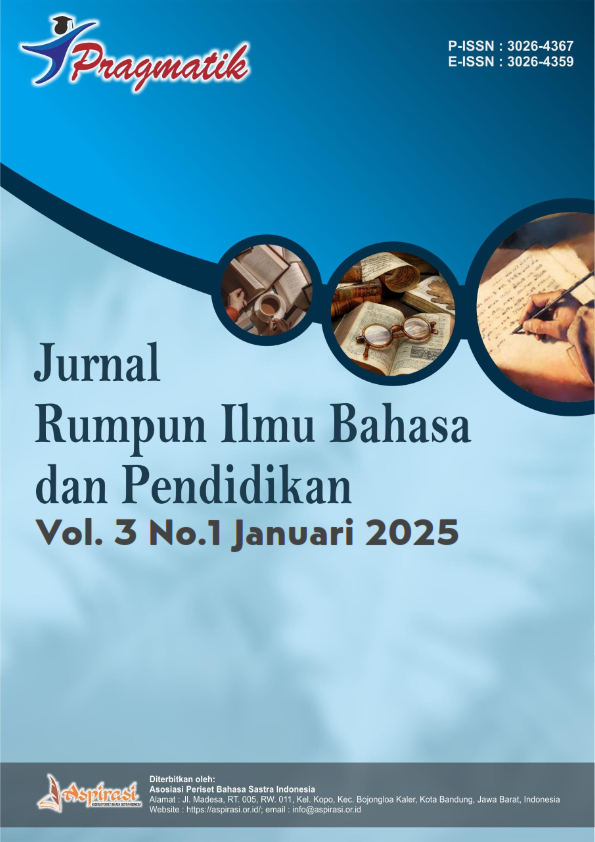A Pragmatic Analysis of Dialogue Between Two Characters in the Old Man and the Sea Based on the Cooperative Principle
DOI:
https://doi.org/10.61132/pragmatik.v3i1.1299Keywords:
Cooperative Principles, Using maxims, PragmaticsAbstract
This study conducts a pragmatic analysis of the dialogue between characters in Ernest Hemingway's "The Old Man and the Sea," utilizing Grice's Cooperative Principle as a theoretical framework. By examining the interactions between Santiago and Manolin, the research highlights how conversational maxims: Quality, Quantity, Relation, and Manner shape their communication. The analysis reveals that while both characters generally adhere to these principles, occasional deviations occur, reflecting their emotional connections and the complexities of their relationship. This investigation not only enhances understanding of the characters' dynamics but also underscores the broader implications of pragmatic theory in literary dialogue. Ultimately, the findings demonstrate that effective communication transcends mere information exchange, emphasizing the importance of fostering relationships and emotional understanding in human interactions.
Downloads
References
Arista, P. (2014). Pragmatics and language education: An overview. Routledge.
Brown, P., & Levinson, S. C. (1987). Politeness: Some universals in language usage. Cambridge University Press.
Davies, C. (2007). The language of conversation. Routledge.
Ealen, A. (2001). Cooperative principles in conversation. Journal of Pragmatics, 33(8), 1347–1361.
Echols, J. M., & Hassan, S. (1999). Implication in language: An overview. Universitas Negeri Jakarta Press.
Hameed Al-Hindawi, F., & Al-Aadili, N. M. (2018). Pragmastylistics: The integration of pragmatics and stylistics. Journal of Kirkuk University, 101.
Grice, H. P. (1975). Logic and conversation. In P. Cole & J. L. Morgan (Eds.), Speech acts (pp. 41–58). Academic Press.
Kecskes, I. (2014). Intercultural pragmatics: An overview. Cambridge University Press.
Kridalaksana, H. (2011). Linguistic pragmatics. Gramedia Pustaka Utama.
Leech, G. N. (1983). Principles of pragmatics. Longman.
Levinson, S. C. (1983). Pragmatics. Cambridge University Press.
Lyons, J. (1995). Linguistic semantics: An introduction. Cambridge University Press.
Miller, A. (2018). The emotional dynamics of Santiago and Manolin’s relationship in Hemingway's text. Journal of Literary Studies, 44(2), 123–145.
Nabanah, A. (1987). Language and culture: A study of the relationship between language and cultural identity.
Parker, F. (1962). Pragmatics: A study of language in context. Routledge.
Potts, C. (2005). The logic of conventional implicature. Nature, 433(7025), 851–855.
Smith, T. (2010). Hemingway’s minimalist style and its implications for character development. Modern Fiction Studies, 56(3), 537–558.
Shirwan, H. (2022). Analysis of the verb number in the expression of speakers in Kurdish. Journal of Kirkuk University, 20.
Wijana, I. M. (1996). Pragmatics in discourse analysis. Journal of Pragmatics, 25(4), 483–497.
Wright, J. (1975). The pragmatics of conversation. Journal of Linguistics, 11(2), 1–20.
Yule, G. (1996). Pragmatics. Oxford University Press.
Downloads
Published
How to Cite
Issue
Section
License
Copyright (c) 2024 Pragmatik : Jurnal Rumpun Ilmu Bahasa dan Pendidikan

This work is licensed under a Creative Commons Attribution-ShareAlike 4.0 International License.





